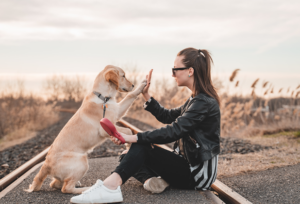Throughout history, humans and animals have shared an intricate and evolving relationship, a tapestry woven with threads of mutual benefit, companionship, and even love. From the earliest days of domestication, when humans and animals first formed alliances, this connection has shaped our societies, influenced our cultures, and enriched our lives in countless ways.

The Domestication Revolution
The domestication of animals, estimated to have begun around 15,000 years ago, marked a pivotal moment in human history. This profound transformation, driven by the need for food, labour, and companionship, reshaped the relationship between humans and animals.
Over millennia, humans selectively bred animals for traits that enhanced their usefulness. Leading to the development of a diverse array of domesticated species, each with unique characteristics and roles in human society. Dogs, cats, horses, sheep, cattle, and countless others became integral parts of human communities, providing food, protection, transportation, and companionship.
Animals as Companions and Partners in Human Endeavors
The role of animals in human society extends far beyond their practical contributions. Over time, animals have evolved into cherished companions, providing emotional support, unconditional love, and a sense of loyalty and devotion that transcends words.
Dogs, with their unwavering loyalty and playful nature, have become beloved family members, offering companionship and unconditional love. Cats, with their enigmatic charm and independent spirits, have captivated our hearts, providing comfort and companionship in our homes. Horses, with their strength and grace, have served as partners in human endeavours. From the battlefields of history to the arenas of modern competition.
The Healing Power of Human-Animal Interactions
The benefits of human-animal interactions extend beyond companionship and emotional support. Numerous studies have demonstrated the therapeutic effects of animal-assisted therapy, particularly for individuals facing physical, emotional, or psychological challenges.
Animals, with their innate ability to provide unconditional love and acceptance. They can play a profound role in reducing stress, lowering anxiety, and promoting a sense of well-being. Whether it’s the gentle purr of a cat. The comforting presence of a therapy dog has the remarkable ability to soothe and heal.
Animals as Sentinels of the Environment
Animals serve as vital indicators of the health of our planet’s ecosystems. Their presence, abundance, and behaviour provide valuable insights into the state of the environment, alerting us to changes in climate, pollution, and habitat destruction.
By monitoring animal populations and behaviour, scientists can gain a critical understanding of the interconnectedness of ecosystems and the potential consequences of human activities. Animals, as integral components of the web of life, serve as sentinels, warning us of environmental threats and guiding us towards sustainable practices.
Conclusion
The relationship between humans and animals is complex and dynamic, constantly evolving in response to changing circumstances and new understanding. As we move forward, it is crucial to recognize the intrinsic value of animals. Not merely as resources or tools but as sentient beings with whom we share our planet.
By promoting ethical treatment, responsible stewardship, and a deeper understanding of animal behaviour, we can foster a harmonious coexistence that benefits both humans and animals. The future of our shared journey depends on our ability to respect, protect, and cherish the diversity and wonder of the animal kingdom.
